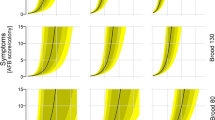Abstract
Infectious processes in a social group are driven by a network of contacts that is generally structured by the organization arising from behavioral and spatial heterogeneities within the group. Although theoretical models of transmission dynamics have placed an overwhelming emphasis on the importance of understanding the network structure in a social group, empirical data regarding such contact structures are rare. In this paper, I analyze the network structure and the correlated transmission dynamics within a honeybee colony as determined by food transfer interactions and the changes produced in it by an experimental manipulation. The study demonstrates that widespread transmission in the colony is correlated to a lower clustering coefficient and higher robustness of the social network. I also show that the social network in the colony is determined by the spatial distribution of various age classes, and the resulting organizational structure provides some amount of immunity to the young individuals. The results of this study demonstrates how, using the honeybee colony as a model system, concepts in network theory can be combined with those in behavioral ecology to gain a better understanding of social transmission processes, especially those related to disease dynamics.




Similar content being viewed by others
References
Albert R, Jeong H, Barabási A (2000) Error and attack tolerance of complex networks. Nature 406:378–382
Anderson RM, May RM (1992) Infectious disease of humans. Oxford University Press, Oxford
Anderson PE, Jensen HJ (2005) Network properties, species abundance and evolution in a model of evolutionary ecology. J Theor Biol 232:551–558
Barthélemy M, Barrat A, Pastor-Satorras R, Vespignani A (2005) Dynamical patterns of epidemic outbreaks in complex heterogeneous networks. J Theor Biol 235:275–288
Corner LAL, Pfeiffer DU, Morris RS (2003) Social-network analysis of Mycobacterium bovis transmission among captive brushtail possums (Trichosurus vulpecula). Prev Vet Med 59:147–167
Dunne JA, Williams RJ, Martinez ND (2002) Food-web structure and network theory: the role of connectance and size. Proc Natl Acad Sci USA 99:12917–12922
Fewell JH (2003) Social insect networks. Science 301:1867–1870
Grenfell BT, Dobson A (1995) Ecology of infectious diseases in natural populations. Cambridge University Press, Cambridge
Hagenaars TJ, Donnelly CA, Ferguson NM (2004) Spatial heterogeneity and the persistence of infectious diseases. J Theor Biol 229:349–359
Jordán F, Scheuring I (2002) Searching for keystones in ecological networks. Oikos 99:607–612
Keeling MJ (1999) The effects of local spatial structure on epidemiological invasions. Proc R Soc Lond B 266:859–867
Keeling M (2005) The implications of network structure for epidemic dynamics. Theor Popul Biol 67:1–8
Krause J, Croft DP, James R (2007) Social network theory in the behavioural sciences: potential applications. Behav Ecol Sociobiol 62:15–27
May RM (2006) Network structure and the biology of populations. Trends Ecol Evol 21:394–399
Mollison D, Isham V, Grenfell B (1994) Epidemics: models and data. J R Stat Soc A 157:115–149
Montoya JM, Sole RV (2002) Small world patterns in food webs. J Theor Biol 214:405–412
Naug D, Camazine S (2002) The role of colony organization in pathogen transmission in social insects. J Theor Biol 215:427–439
Naug D, Smith BH (2007) Experimentally induced change in infectious period affects transmission dynamics in a social group. Proc R Soc Lond B 274:61–65
Newman MEJ (2003) Properties of highly clustered networks. Phys Rev E 68:026121
Newman MEJ (2004) Analysis of weighted networks. Phys Rev E 70:056131
Oster GF, Wilson EO (1978) Caste and ecology in the social insects. Princeton University Press, Princeton
Read JM, Keeling MJ (2003) Disease evolution on networks: the role of contact structure. Proc R Soc Lond B 270:699–708
Saramäki J, Kaski K (2005) Modelling development of epidemics with dynamic small-world networks. J Theor Biol 234:413–421
Schmid-Hempel P (1998) Parasites in social insects. Princeton University Press, Princeton
Sokal RR, Rohlf FJ (1995) Biometry, 3rd edn. Freeman, New York
Tofts C (1993) Algorithms for task allocation in ants (a study of temporal polyethism: theory). Bull Math Biol 55:891–918
Verdasca J, Telo da Gama MM, Nunesa A, Bernardinoa NR, Pacheco JM, Gomes MC (2005) Recurrent epidemics in small world networks. J Theor Biol 233:553–561
Acknowledgments
This work is supported by a grant from the National Science Foundation, USA. I thank Ann Gibbs and Robert Wildermuth for help with the video data, H.S. Arathi for extensive discussions, and two anonymous referees for their insightful comments.
Author information
Authors and Affiliations
Corresponding author
Additional information
Communicated by J. Krause
Rights and permissions
About this article
Cite this article
Naug, D. Structure of the social network and its influence on transmission dynamics in a honeybee colony. Behav Ecol Sociobiol 62, 1719–1725 (2008). https://doi.org/10.1007/s00265-008-0600-x
Received:
Revised:
Accepted:
Published:
Issue Date:
DOI: https://doi.org/10.1007/s00265-008-0600-x




